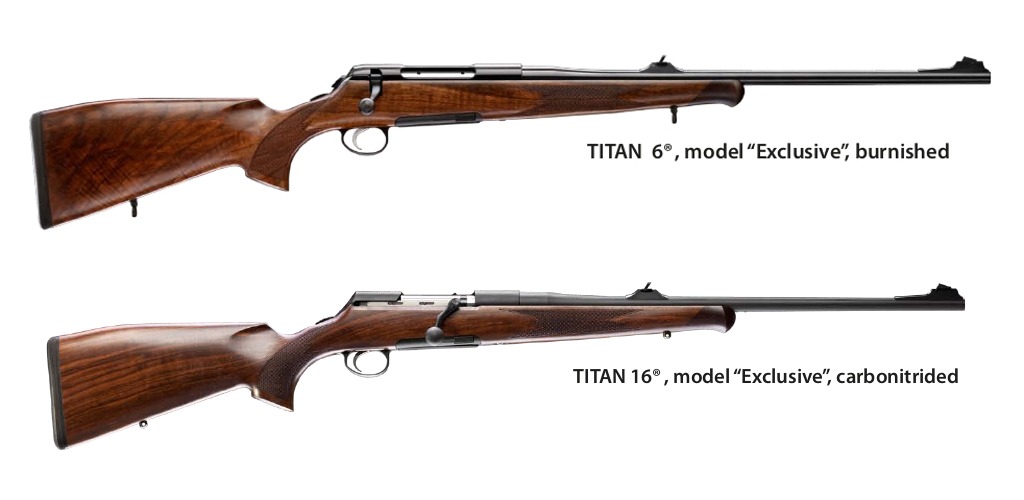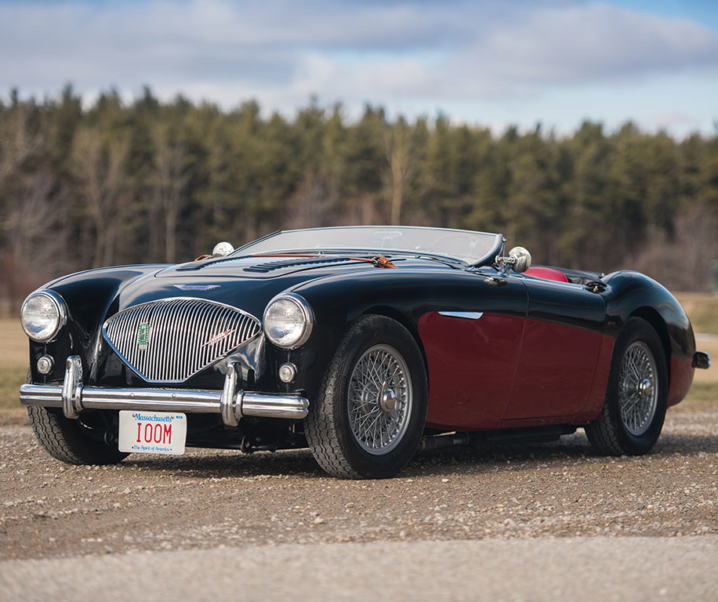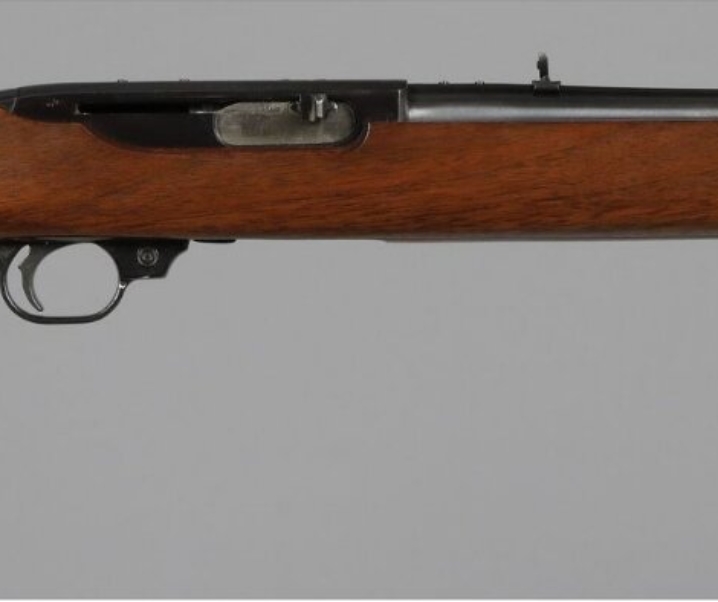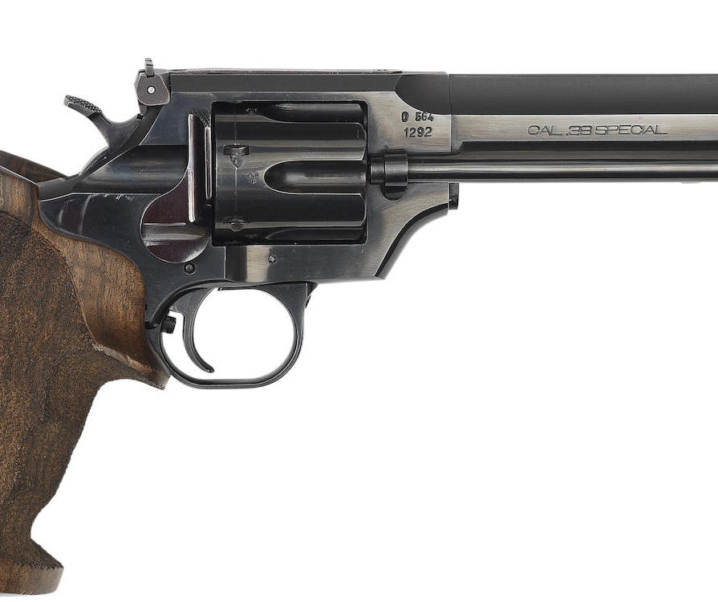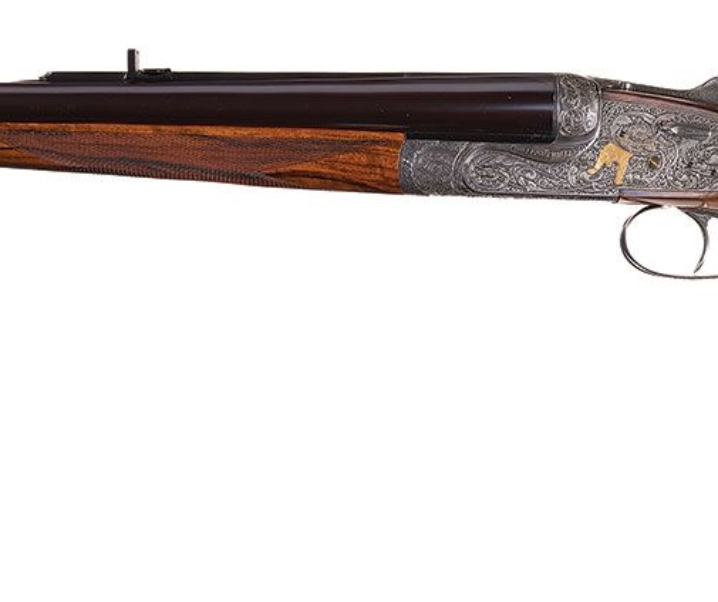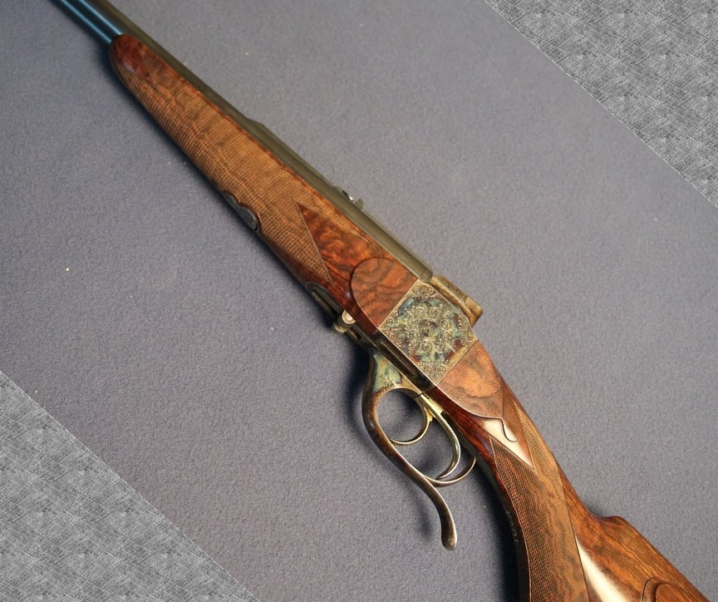Introduction
Austria has produced some of the most famous firearms in the world. In the modern era the Austrian Glock has become “the” must have pistol for civilians and law enforcement alike. The Glock “plastic fantastic” can be found on the hip of law enforcement officers in the United States, Britain, Australia, and if you visit the Western Wall in Jerusalem, you’ll see the police there Glock equipped.
Before the Glock the best known Austrian firearm was the Mannlicher-Schönauer rifle, which possessed the smoothest bolt action ever created, an action so smooth that if you sharply angled the rifle to a muzzle down position that the bolt would not only fall forward but the action would close completely all by itself.
Austria has a long tradition of excellence in firearms creation, both excellence in design and excellence in manufacture, so the emergence of a relatively new maker is of great interest to those of us who appreciate fine sporting rifles.
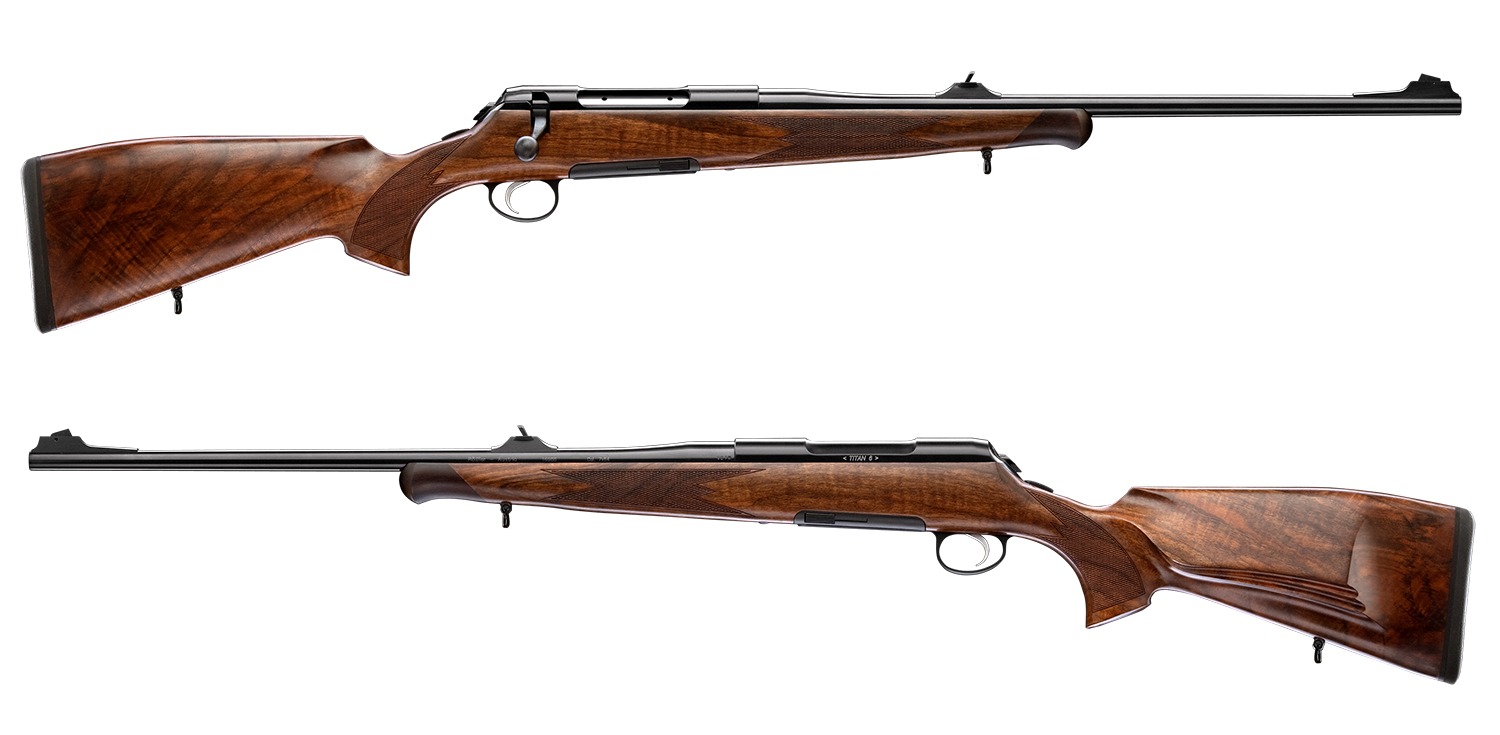
That new manufacturer is Rößler (pronounced and normally spelled “Roessler” in English just as Mannlicher-Schönauer is normally spelled “Mannlicher-Schoenauer” in English). Rößler was founded by Eric Rößler in 1996 and the company is based in Kufstein in Austria. Rößler began by making small order traditional Austrian style sporting rifles such as lightweight single shot, combination guns (one shotgun and one rifle barrel), and the unusual and technically challenging “bergstutzen” (i.e. Mountain Carbine/Rifle), which is an over-under double rifle with two different caliber barrels, a small caliber such as .222, .223 or 5.6x52R, and a larger caliber such as 7x57R, 30-06 or up to the 9.3x74R. The bergstutzen requires that the two different caliber barrels be regulated so they shoot to the same point of impact at a set range with the cartridges the rifle is set up for. The idea of the bergstutzen being to provide what are essentially two single shot rifles in one so the hunter is able to use it for smaller game such as fox, or for larger game such as deer or chamois depending on what he/she encounters.
The Rößler business flourished and Erich Rößler’s son Walter also joined the business making it a father and son operation. Work was commenced on a Rößler designed turn-bolt action rifle and the result was the switch barrel Titan 6 which made its debut in March 2002.
The company expanded its product line to four models of sporting rifle, the Titanalpha, Titan 3 and Titan 6, which are turn-bolt action rifles, and the innovative Titan 16 which is a straight pull bolt action featuring no less than 16 front locking lugs. The Titan 16 will look familiar to straight pull sporting rifle aficionados as it has been marketed previously by Mauser as their M96.
The Titanalpha, Titan 3 and Titan 6
The Titan 3 is the small caliber version of the Rößler Titan rifles. The Titan 3 action has, as its name suggests, three front locking lugs, giving it a 60° bolt lift. The bolt locks directly into the barrel as is common for many switch barrel rifles, and it is made for an interesting range of small cartridges: 5.6×50 Magnum, 22-250 Remington, 222 Remington, 223 Remington, 6mm Norma BR, 300 Whisper, and 7.62×39.
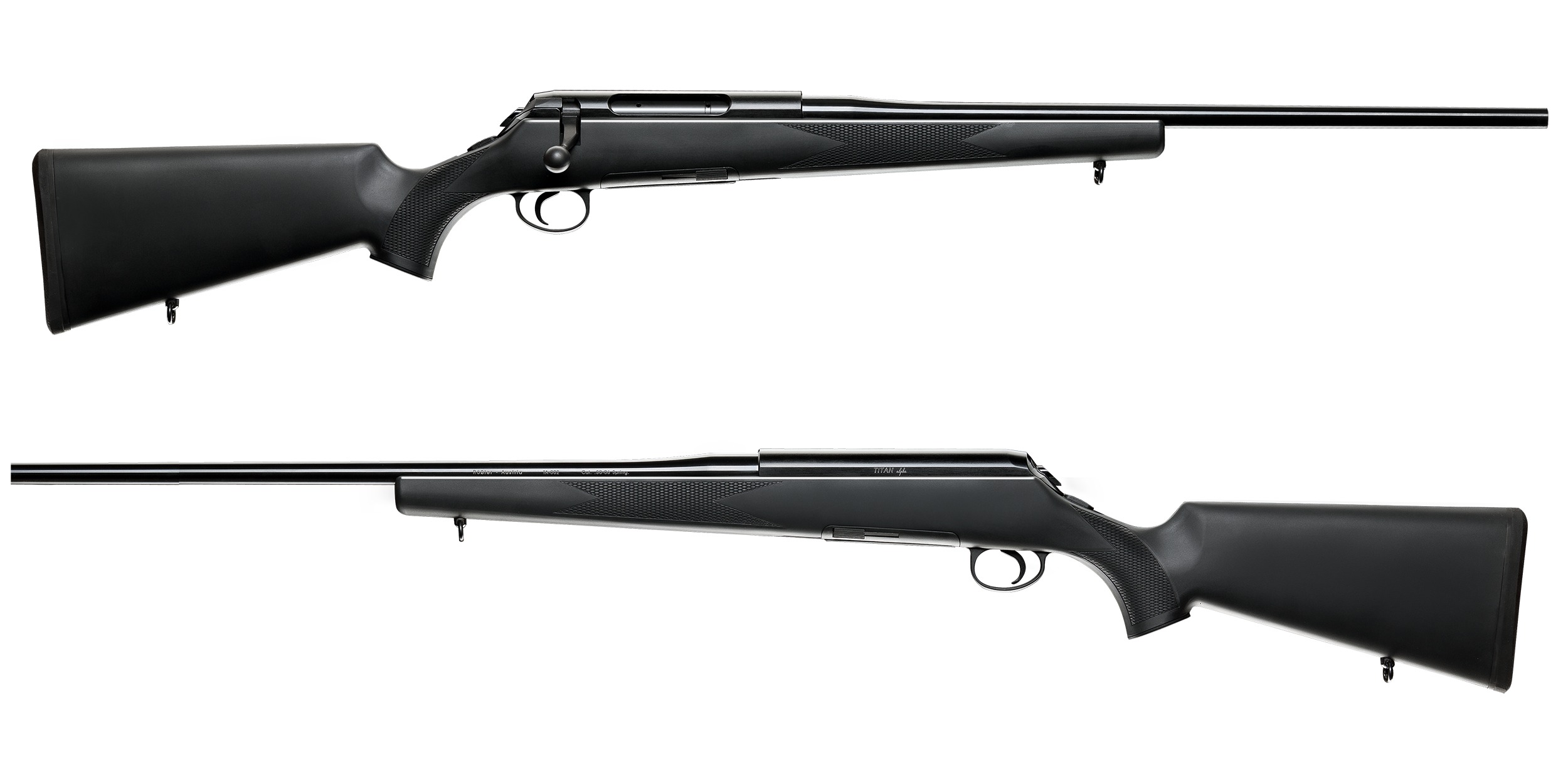
Also using a three locking lug action is the inexpensive entry level Titanalpha which is made in standard calibers and one magnum; 6.5×55 Swedish, 308 Winchester, 8x57IS, 25-06, 270 Winchester, 7×64, 30-06 Springfield, and 7mm Remington Magnum.
The Titan 6 is very much like the Titan 3 except that it is made for medium to large rifle calibers and has six front locking lugs, so, like its smaller sibling, it provides a short 60° bolt lift as opposed to the 90° bolt lift of a two locking lug action. The 60° bolt lift provides some advantages and some trade-offs but it has become very common on modern sporting rifles. The first rifle I owned that featured a 60° bolt lift was my Mannlicher-Schönauer M72 in 6.5×68 which I acquired in 1980.
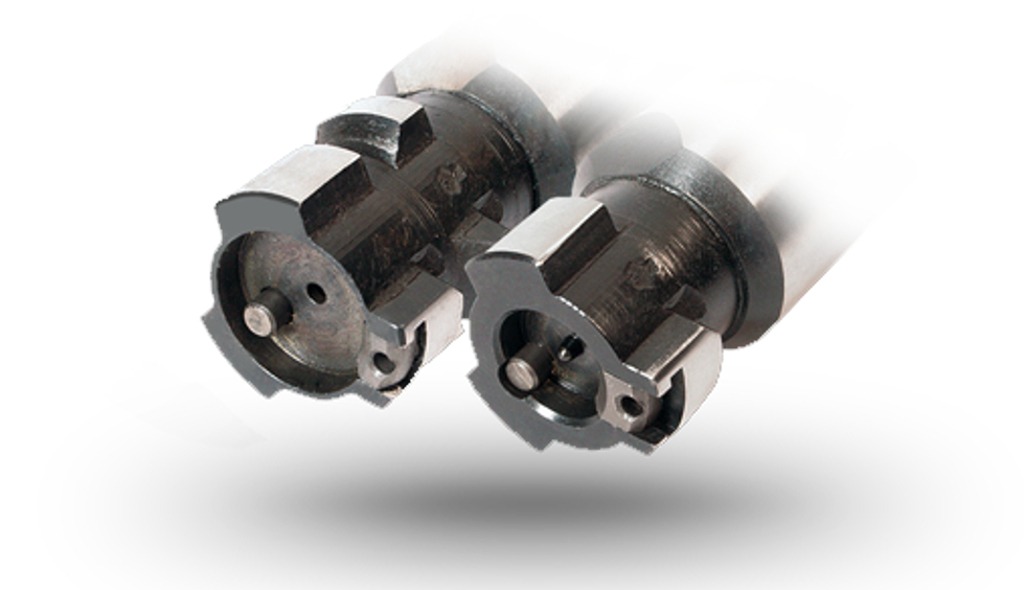
Because the bolt lift is shorter the 60° lift keeps the bolt handle clear of the lowest mounted riflescope as the lifted bolt handle is typically just above horizontal. On the other hand, due to cocking and extraction operations being compressed into 60° instead of the 90° of a two lug action such as the Mauser ’98 and the Winchester Model 70 the bolt lift can be expected to be a bit stiffer, but it will feel crisp. So there is a bit less camming power in the 60° three lug style action to extract a sticky cartridge case, something that is normally not a problem. Some claim that the 60° is a bit faster to operate but I don’t find that to be the case, for me at least. That being said the 60° bolt lift equipped rifles I have used have a nice efficient feel about them in operation.

The shortest bolt handle lift on a sporting rifle action that I have encountered was the 45° lift on the old Danish Schultz & Larsen, an action that was used for the early Weatherby rifles including the 378 Weatherby Magnum: so if a 45° bolt lift is fine for a 378 Weatherby Magnum then the 60° bolt lift of the Titan 3 and 6 is plenty for the cartridges these rifles are chambered for.
The list of calibers that the Titan 6 is chambered for is long but we’ll list them here so you can scan the list and quickly see if your favorites are there: 6XC, 243 Winchester, 25-06 Remington, 6.5×47 Lapua, 6.5 Creedmore, 6.5×55 Swedish, 6.5×57, 6.5×65 RWS, 6.5×68, 6.5-284 Norma, 270 Winchester, 270 Winchester Short Magnum, 7mm-08 Remington, 7×57, 7×64, 7mm Remington Magnum, 300 Winchester Short Magnum, 300 Winchester Magnum, 308 Winchester, 30-06 Springfield, 8x57IS, 8x68S, 8.5×63 Reb, 338 Winchester Magnum, 358 Winchester, 9.3×62, 375 Ruger. This looks to me to be an intelligently chosen range that provides good choices regardless of what country you are in and the legislative framework you have to deal with.
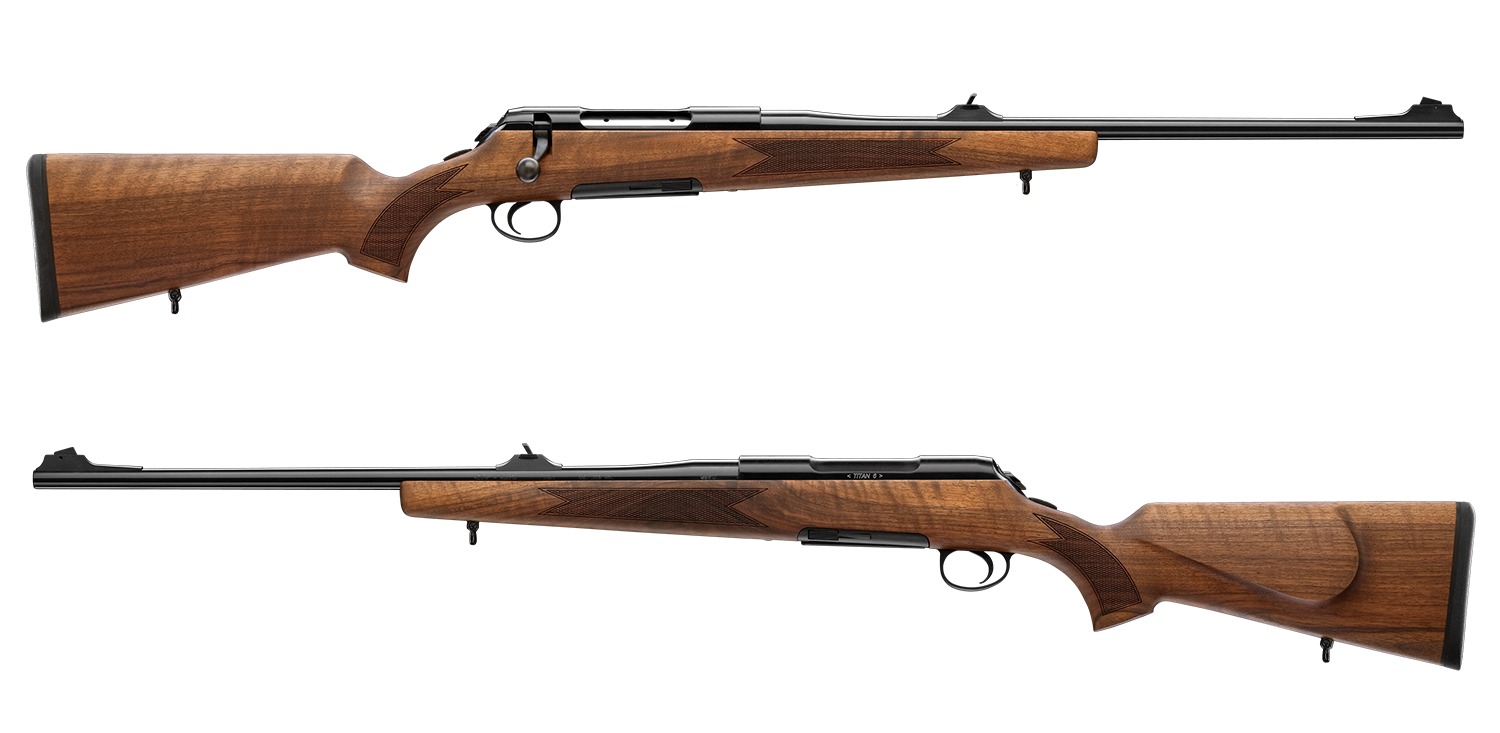
The Titan 3 and 6 are completely modern in design and construction. The receiver is made from aircraft grade aluminum just as the engine block of a Porsche 911 was (Note: Dr Porsche was Austrian and the car company was first established in Austria). As an additional cost option the customer can order their Titan 6 with a steel receiver. The bolt is steel with the locking lugs at the front. The locking lug recesses are machined into the barrel so the aluminum does not have to withstand the pressures or bolt thrust of firing. Thus the action can be made lightweight keeping the weight of the complete rifle down to comfortable levels. Both the Titan 3 and 6 tip the scales at about 2.9kg (6.4 lb) depending on caliber and barrel fitted. So if you are planning on one of those “Climb every mountain, ford every stream …” hunting trips then the lighter the rifle the better and that aluminum receiver will be a delightful blessing, all the more so at the end of a long day if you are carrying a backpack full of meat back to camp in addition to the rifle.
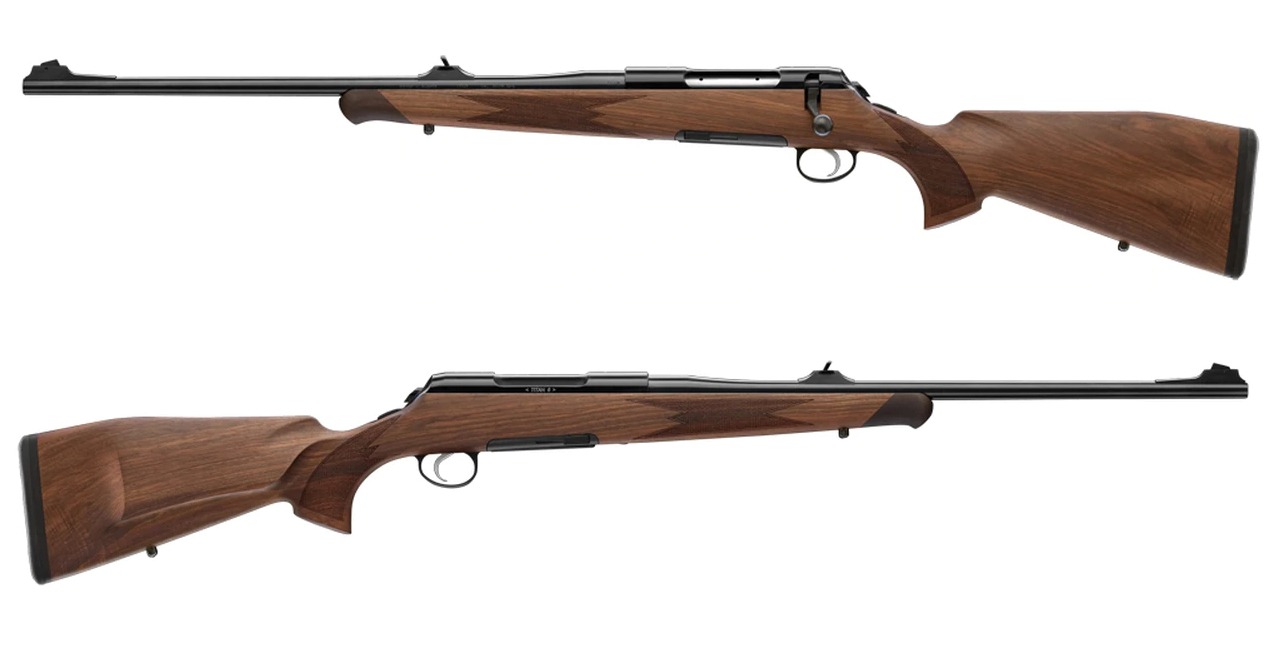
Another plus to having a bare rifle that weighs about the same as a lightweight lever action such as the Marlin M1894 is that you can choose to fit it with a large high performance but heavy riflescope if you choose, and still keep the overall weight of your rifle light and comfortable.
Another weight saving aspect of the Titan rifles is that the trigger-guard and floorplate is made of light polycarbonate, similar to the material used in the Glock handguns. For those who prefer steel or aluminum rather than polycarbonate you can order your Rößler Titan with an aluminum trigger guard and floorplate assembly and can also order your standard capacity magazine with a steel base: being an old fashioned guy with an old fashioned mind that is an option I would specify. All that being said the polycarbonate is light, durable and entirely practical, as experience with polycarbonate on such pistols as the Glock has demonstrated.
Bedding, Barrel Options, and the Barrel Switching System
The action bedding system used in the Titan 6 has an aluminum pillar bedded into the stock at the rear with the rear action screw located in that. At the front there is a polycarbonate surround bedded into the wood into which the barrel retaining block of the receiver fits. The barrel is mounted into the receiver by simply pushing it into the receiver ring. Once the two retaining screws in the block under the front of the receiver are loosened the barrel can be pulled out and a new one pushed in. There is a notch to ensure that the barrel is correctly aligned, and once in place the two retaining screws are tightened to 7 Newton Meters (62 inch pounds – 5.15 lb/ft), preferably using a suitable torque wrench. Once that is done the action can be refitted into the stock and the front and rear action screws also torqued tight to 7 Newton Meters.
The video below courtesy of Rößler shows just how easy this process is to do.
[arve url=”https://www.youtube.com/watch?v=v0-jx7PKNj4″ /]
When changing barrels the same bolt can be used if one is changing to a cartridge that uses the same (or very similar) case head size. So switching barrels for such standard calibers as the 243 Winchester, 308 Winchester, 30-06, 7×64 or 9.3×62 does not require a different bolt. But, if you want to go from a cartridge using a standard size case head to one of the larger diameter magnums then you would need a bolt made for that size group of cartridge cases.
In the same way if you have a magnum caliber rifle in something like 7mm Remington Magnum or 300 Winchester Magnum and want to add a 338 Winchester Magnum or 375 Ruger barrel you can without a new bolt because the case rim diameters are the same.
So the only time a different bolt is needed is if a cartridge with a different size case head/rim is required.
Magazines are made for cartridges of similar size in groups. So for example a magazine for the 30-06 accommodates all similar rounds such as the 270 Winchester and 7×64 etc.
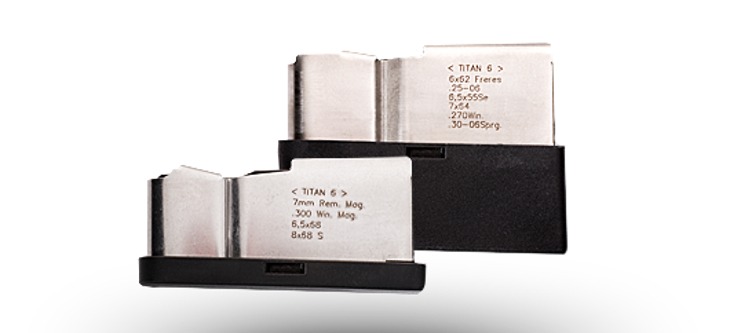
Rößler offer a wide range of barrel options with muzzle diameters of either 15mm or 19mm in standard lengths 51cm, 56cm, and 61cm. They also offer special order lengths of 65cm and 70cm. Barrels can be ordered fluted if desired.
There are of course more possible reasons for wanting a switch barrel rifle than just wanting to be able to change calibers. One might not want to change calibers but might want to be able to change barrel length or profile. For example one might have two 30-06 barrels, a short 56cm one for woods hunting and a light profile or fluted 65cm one for mountain or plains hunting.
Being able to transport a rifle with the barrel removed makes it easier to pack away into a shorter rifle case which is more convenient whether traveling by car or flying.
This chart from the Rößler catalog provides a clear picture of the many options. It is possible to fit a Titan 3 bolt and barrel to a Titan 6 and vice-versa. The receivers of the Titan 3 and 6 are identical so it is easy to convert your small caliber Titan 3 to use full size Titan 6 bolts and barrels, or do the opposite.
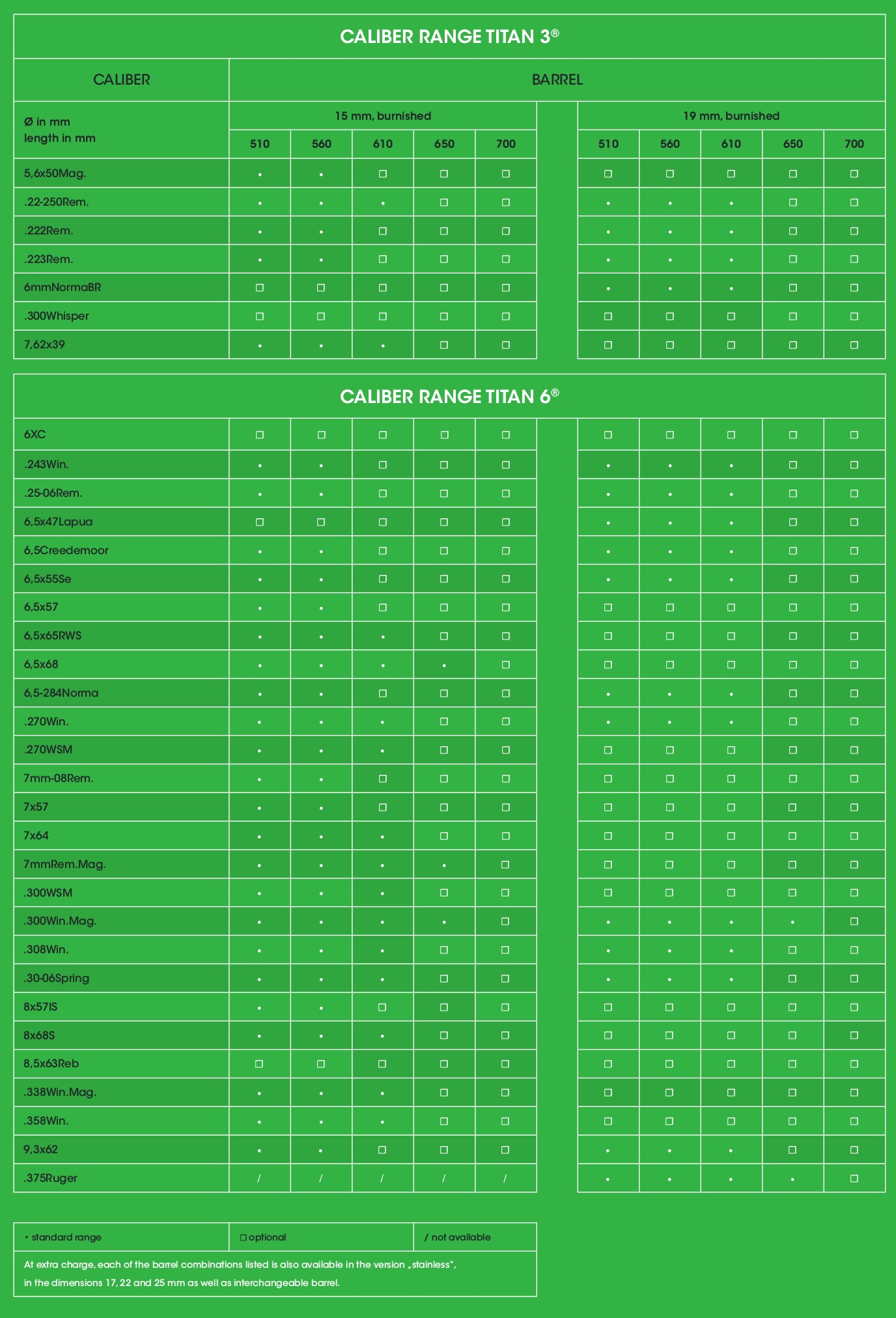
The Titan 16
The Titan 16 is different from the other Titan models in that it uses a completely different action which is made of steel. The Titan 16 is a straight pull rifle and it was originally sold by Mauser as their M96 (also referred to as the Mauser M1996). Thus instead of needing to turn the bolt handle up, then cycling it back and forth, and then turning the bolt handle back down again to lock the action closed for firing, to cycle the Titan 16 you simply pull the handle back and then push it forward, which is fast and instinctive.

Rößler have updated the design for this rifle so that it has the same switch barrel capability as the other Titan rifles, and they have adapted it so it uses a polymer floorplate and detachable magazines like the Titan 6.
The Titan 16 is made in the same range of calibers as the Titan 6 and it is also a switch barrel rifle so barrels of different calibers, different lengths and profiles can be used to dramatically transform the rifle whenever desired.
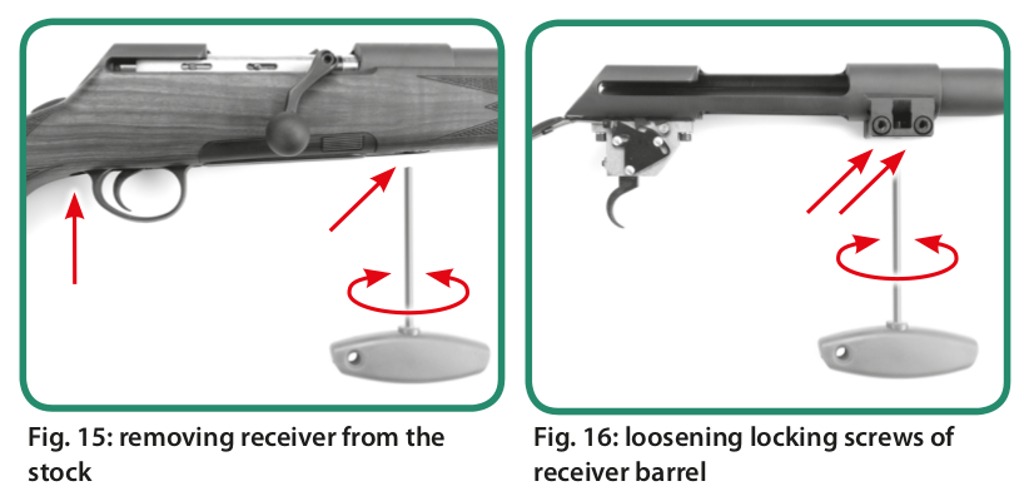
Because the Titan 16 uses a different action with 16 locking lugs instead of 6 the barrels from the Titan 6 range are not interchangeable with it, but the method of changing barrels remains the same.
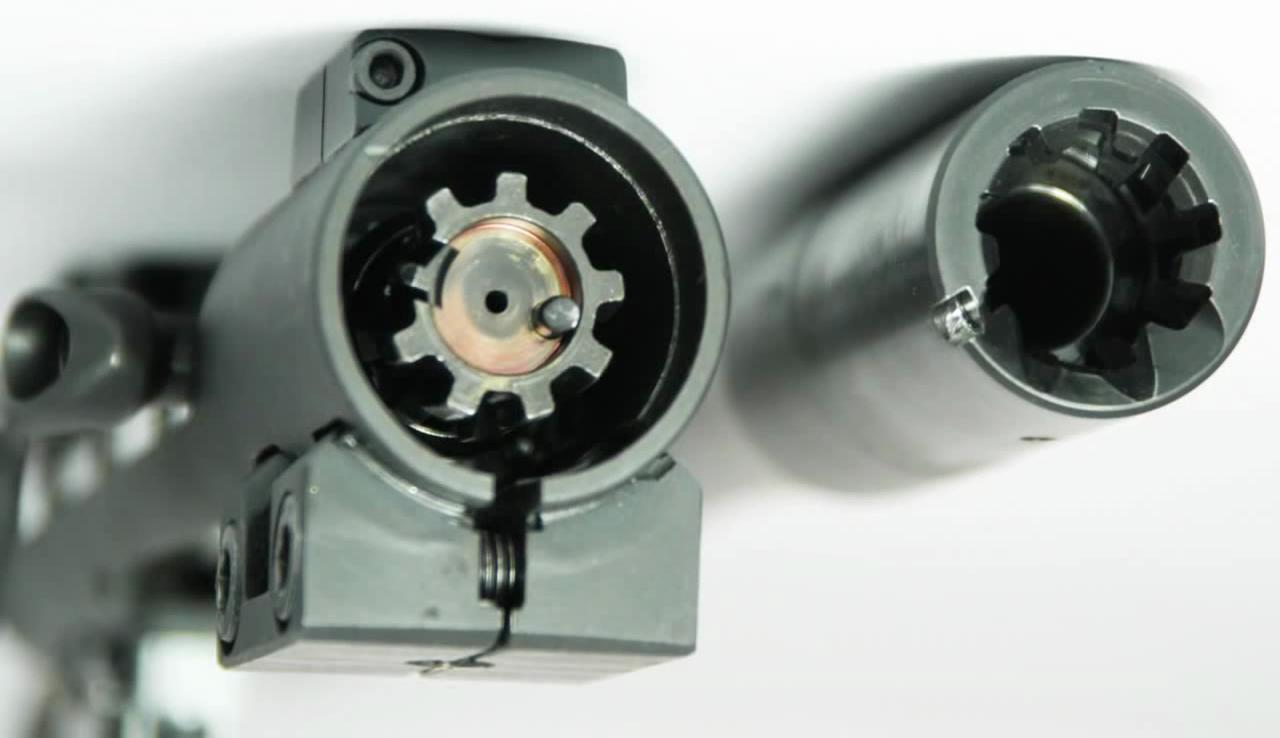
The below video from Australian distributor Herman’s Guns provides a superb overview of the Titan 16’s features and accuracy.
[arve url=”https://www.youtube.com/watch?v=BLF8m2lioIc” /]
Magazines
All the Rößler Titan rifles use single column removable magazines that feature a shoulder so that the magazine retains cartridge cases at the shoulder and thus prevents any recoil damage to soft pointed bullets. Damage to a soft point bullet alters its ballistic properties and affects the bullet’s flight path, so avoiding that kind of damage is beneficial.
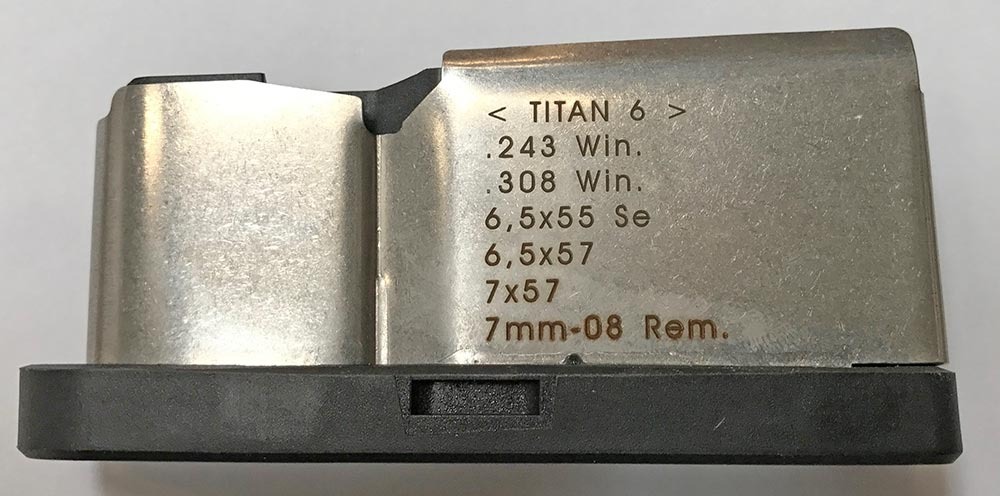
Another advantage of a single column magazine is that they tend to provide more reliable feeding than a staggered column magazine. The single column magazine places the cartridge in perfect alignment with the chamber whereas a staggered column magazine has to feed the cartridges from a position off to the side.
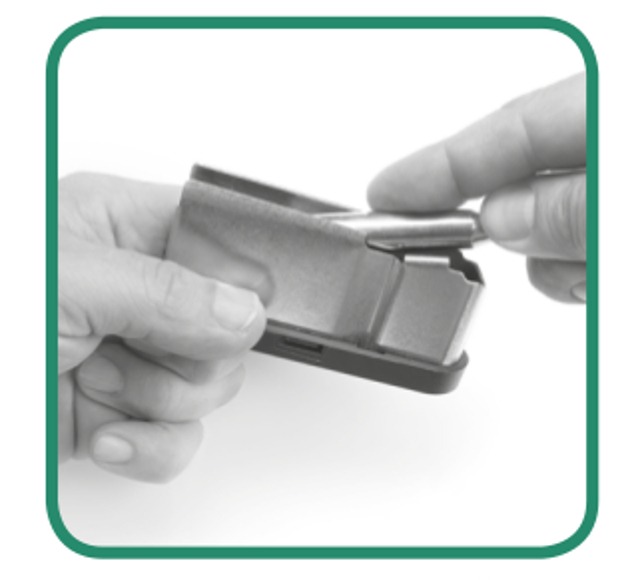
The Rößler Titan magazines are removed from the rifle by depressing the catches on either side of the magazine well and they spring out into the hand making removal and replacement quick and easy.
Because the Titan rifles all use a push feed type of action it is easy to simply drop a cartridge into the chamber if the magazine is empty and an extra shot is needed. Similarly if the shooter has a spare magazine or two for his/her rifle then reloading is quick and easy.
The Titan magazines hold three standard size cartridges or two magnum. For the Titan 6 and 16 higher capacity magazines are available which add two rounds to the capacity, five standard cartridges or four magnum.
Trigger Types and Safety Catches
The Titan rifles can be had with one of two trigger types; the first is the “fine” trigger, which is a single stage adjustable trigger, similar in style and performance to the Winchester Model 70 “MOA” trigger. The second is the European style single “set” trigger. Lock time is of the order of 1.7 milliseconds which is extremely quick.
Each of these trigger types has a slightly different safety catch, and for all models the safety catch is conveniently mounted on the tang.
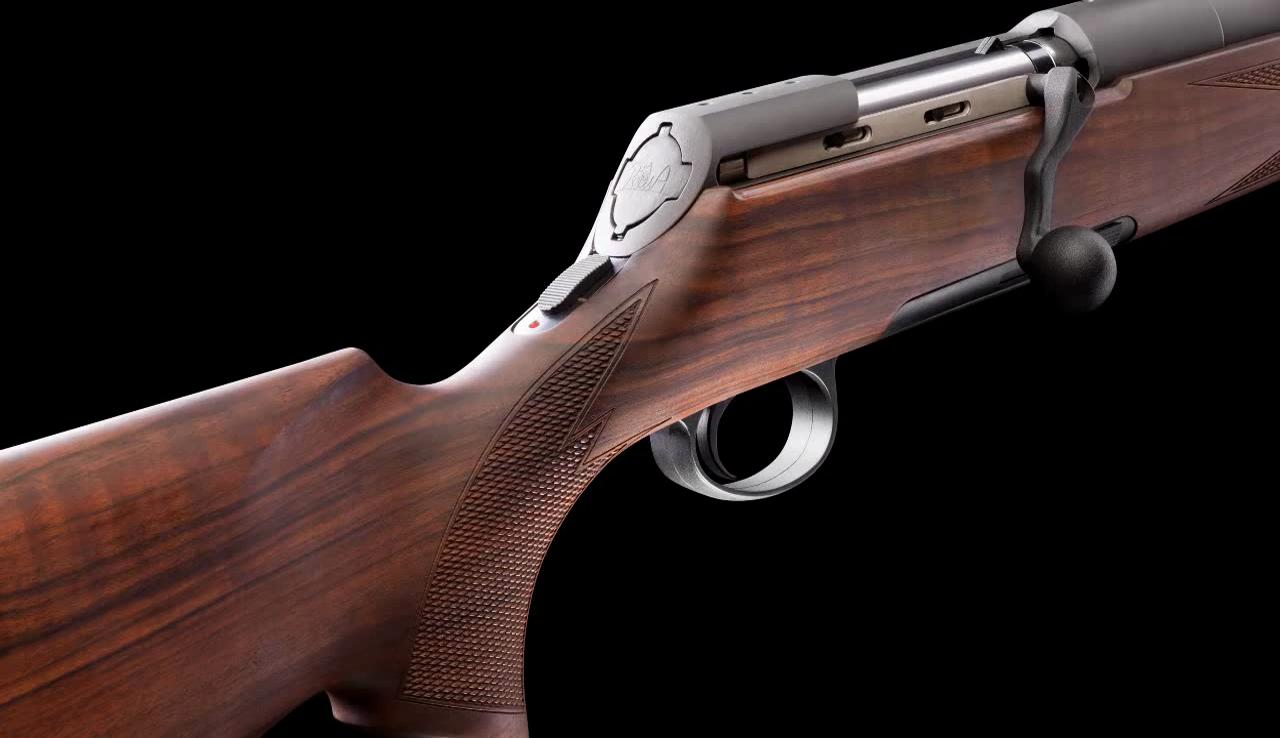
The Titan “fine” trigger provides an approximately 2lb single stage trigger with no over-travel, and this is adjustable both for weight and travel. For this trigger type Rößler provide a three position safety catch.
This three position safety catch enables the rifle to be locked closed on “safe”, in which condition the bolt handle, trigger and striker are all blocked. In the middle position the trigger and striker remain blocked but the bolt can be opened, so this is the safest way to load or unload a cartridge in the chamber. When the safety is pushed fully forward it is disengaged and the rifle can be fired.
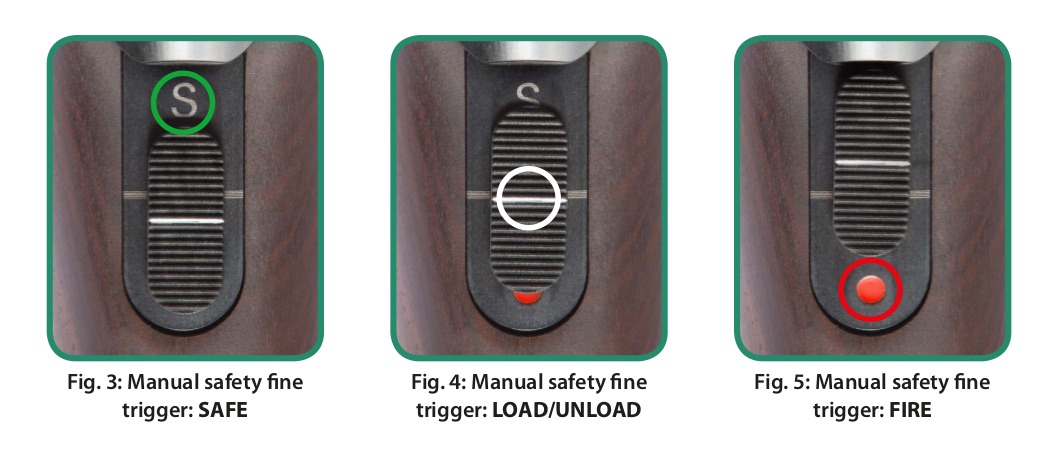
Rifles equipped with the European single set trigger are equipped with a two position safety catch: fully forward for “fire”, and fully to the rear for “safe” with the bolt, striker and trigger blocked.
The European single set trigger is a dual function trigger. If the shooter does not set the trigger it functions as a conventional single stage trigger, so simply pressing the trigger will cause the rifle to fire.
In order to set the trigger, the trigger is pushed forwards which will cause it to click into a more forward position. In this state the trigger pressure is set very light – typically as a “hair” trigger: so the trigger is only “set” just before firing. If the shooter changes their mind and decides not to shoot then un-setting the trigger is normally accomplished by engaging the safety catch, and then, with the muzzle pointed in a safe direction, to press the trigger to trip it which will cause it to un-set.
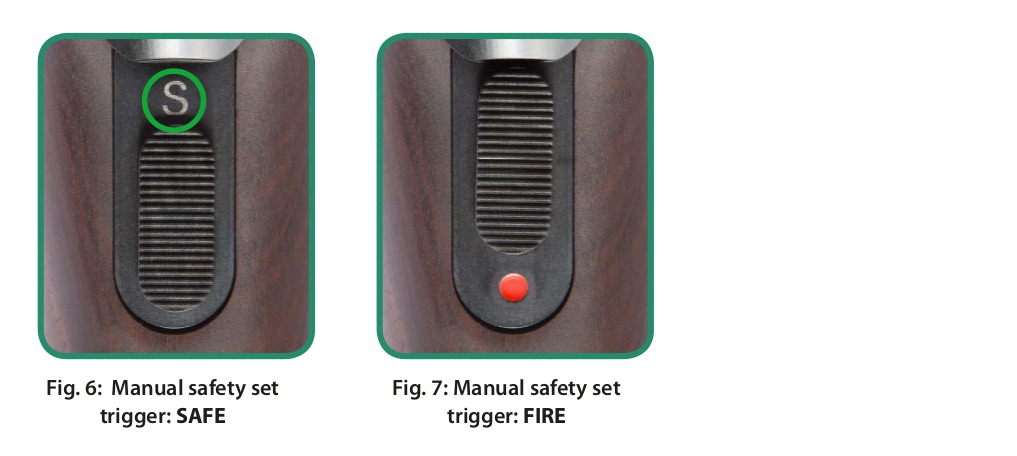
Either double set or single set triggers are very common on European rifles and have been so since the days of the flintlock rifle. They are also a common feature of American flintlock rifles.
Stock Styles
The Rößler Titan 3 and 6 rifles are not only made in traditional hunting styles but also in styles for target shooting and tactical applications.
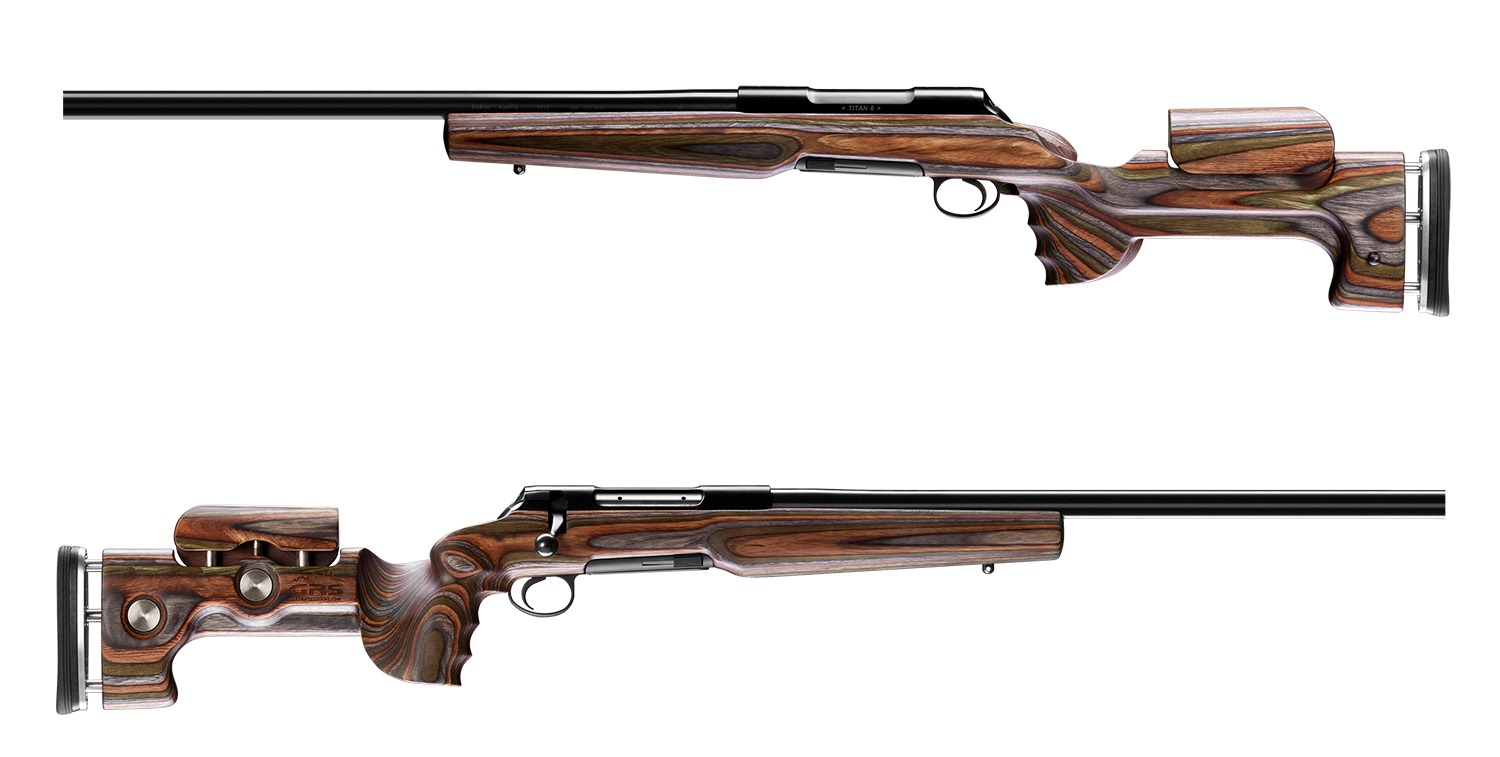
Here are a few examples of the stock styles that are available for the Titan rifles including the Titan 3, Titan 6, and straight pull Titan 16.








The best way to see the many possibilities for a Titan rifle is to visit the Rößler website, or the website of your country’s dealer.
Sights and Mounts
Rößler offers the Titan models with open sights and these are a modest extra cost option. You will find details if you try the Configurator for the Titan 6 or Titan 16 on the Rößler website.
You’ll find the configurator for the turn bolt Titan 6 if you click here.
You’ll find the configurator for the straight pull Titan 16 if you click here.
Rößler dealers have suitable mounts for the Titan rifles and these range from a simple Picatinny rail or Weaver style base to things much more exotic, depending on your taste and the quantity of nice crisp banknotes in your wallet.
Also of interest is the statement in “Gun Tests” of April 2015 that they discovered that Remington bases fitted their Titan 6 test rifle. So if the Titan 6 and Titan 3 can use the same bases as the Remington 700 then that would make installing an optical sight a very simple operation. If that turns out to be the case then my choice would be to go for Talley double lever detachable mounts which I have a great deal of respect for.
Other mount options include the very nice but expensive German Ernst Apel (EAW) which I also have much respect for having had them on a couple of my rifles.
All that being said, the Titan 3 and 6 rifles with their tang mounted safety and low 60° bolt lift ensure you can mount a riflescope pretty much as low as you could possibly want: and the same applies to the straight pull Titan 16.
Conclusion
The Rößler Titan rifles offer intelligent design and excellence in craftsmanship: and they offer that at reasonable prices, especially in the entry level Titanalpha, and the Titan 3 and 6 Standard models.
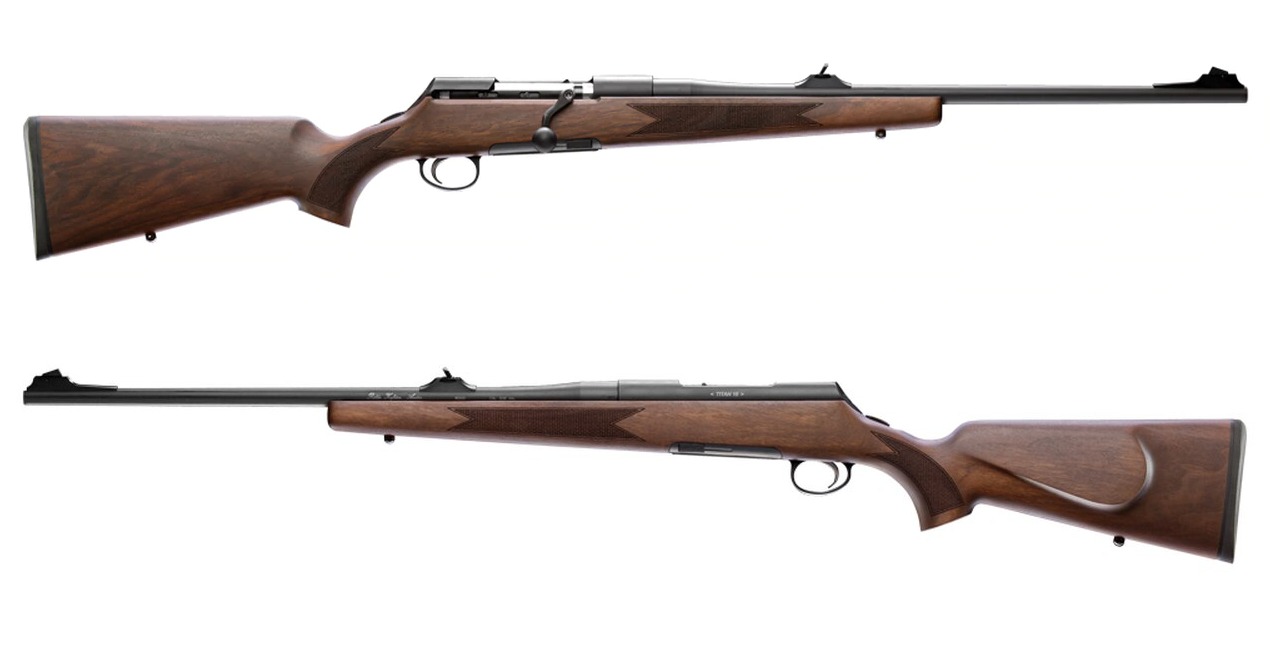
The range of design options available for these rifles make them a strong candidate for whatever rifle you might want to create, from target or varmint rifle through standard hunting up to and including a dangerous game rifle. The availability of not only the 9.3×62 but also the 375 Ruger means that these rifles are legal for dangerous game in most countries of Africa. Not only are the Rößler Titan 6 and 16 made in suitable calibers for dangerous game but they also both enable the hunter to carry the rifle cocked and locked with the safety catch engaged. This is not the case with some European rifles made nowadays because many seem to favor the “cock and de-cock” style of safety system which forces the hunter to carry the rifle de-cocked on the approach to game: or to carry cocked and unlocked – neither of which is desirable when dealing with a quarry that is potentially dangerous, in my view at least. So this makes the Rößler Titan 16 one of the very few European straight pull rifles that I might choose as a dangerous game rifle for an excursion to Africa or Australia’s Northern Territory in search of buffalo or Banteng.
The Rößler Titan rifles are twenty-first century design done with a great sense of practicality. We hope they do as well as they clearly deserve to and that the rifle models Rößler are offering will still be in production for many decades to come.
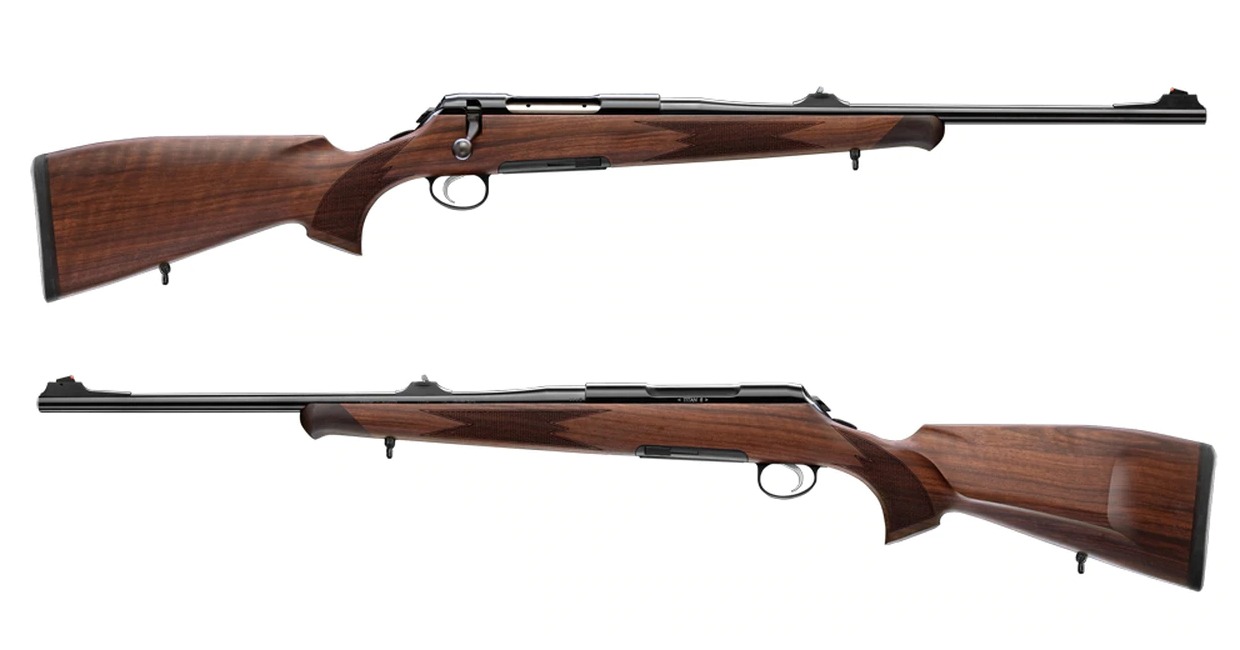
For those in the United States Rößler Titan rifles are imported by TR Imports and you’ll find their website if you click here.
For those in Australia the Rößler Titan rifles are imported by Herman’s Guns and you’ll find their website if you click here.
For those in other parts of the world please check Rößler’s list of national dealers which you’ll find if you click here.
The best way to become familiar with the many options available for a Rößler Titan rifle is to try the Rößler Rifle Configurator for the model you are interested in.
For the Titan 3 and Titan 6 click here.
For the Titan 16 click here.
For the Titanalpha click here.
You will find the User’s Manual for the Titan rifles if you click here.
You will find the Rößler catalog if you click here.
(Picture and media credits: all pictures courtesy Rößler and Herman’s Guns).

Jon Branch is the founder and senior editor of Revivaler and has written a significant number of articles for various publications including official Buying Guides for eBay, classic car articles for Hagerty, magazine articles for both the Australian Shooters Journal and the Australian Shooter, and he’s a long time contributor to Silodrome.
Jon has done radio, television, magazine and newspaper interviews on various issues, and has traveled extensively, having lived in Britain, Australia, China and Hong Kong. His travels have taken him to Indonesia, Israel, Italy, Japan and a number of other countries. He has studied the Japanese sword arts and has a long history of involvement in the shooting sports, which has included authoring submissions to government on various firearms related issues and assisting in the design and establishment of shooting ranges.

